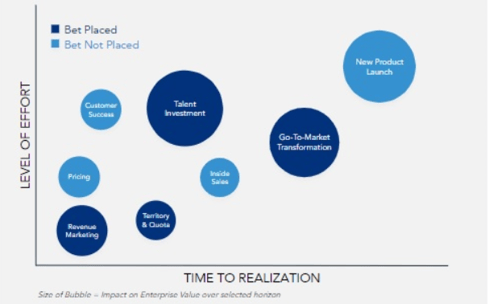Leadership teams tend to activate multiple growth levers and ultimately cause friction in the business—a common problem. For CEOs wanting to create clarity and drive growth amidst uncertainty, they need to get on their front foot and drive relentless focus on a short set of key growth imperatives.
CEO uncertainty often manifests as broad-reaching growth strategies with (too) many active bets. Within PE-backed tech and tech-enabled services sectors, SBI has consistently seen a tightly-defined, singularly-focused value creation strategy outperform businesses claiming highly-adaptive agile growth strategies. Determining which bets to place is the critical next step in creating clarity in your short and long-term value creation strategy.
You’ve worked with your commercial teams to identify growth levers and have reviewed an inventory of bets, it's now time to decide which bets to place. Led by the CEO and CFO, the executive team will collaborate to evaluate and narrow down the list of growth levers and identify 3-5 strategic priorities based on time to realization, level of effort, and impact on enterprise value. Any less, you back yourself into an unwanted corner, any more and you create confusion for your teams. These 3-5 priorities should have a significant impact, be achievable, and align towards a common commercial goal.
Quantifying the time, effort, and ROI of potential bets allows executives to make objective, informed tradeoff decisions versus making subjective or reactive decisions on where to make strategic investments. It also helps understand when to expect results so teams don’t lose patience and change direction prematurely.
How do you narrow your options and select the best bets?
- Clearly define your growth targets
- Use bottoms-up analysis to determine what can be achieved
- Define the gap to growth targets
- Create a revenue plan of how go-to-market teams will strategically align to execute the bets and achieve targets
Evaluate each potential bet with the following criteria:
1) Time to Realization
How long before you see a return on your investment? Assign a time frame to each priority to determine where you will see growth in the shorter and longer term.
2) Level of Effort
How many resources and changes will this bet take to implement? Be realistic about the activities and allocation of resources for achievement.
3) Impact on Enterprise Value
How much return on your investment can you expect?

For a number of CEOs in SBI’s growth planning survey results, growth plans remain uncertain, with a mix of too many growth imperatives; and the wrong growth imperatives underway. Top CEOs are getting crisper on their value creation strategy, evolving that strategy to account for less commercial investment, and determining new productivity levers to still meet growth expectations. This strategic clarity leads top growth CEOs toward a small set of highly focused growth imperatives.
Need help determining which growth levers to pull for near and long-term growth? Click here for SBI’s value creation planning guide.

